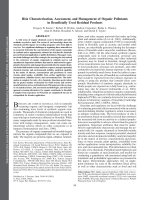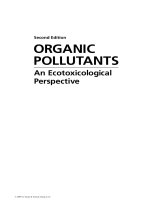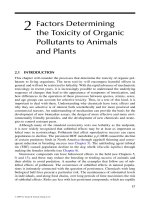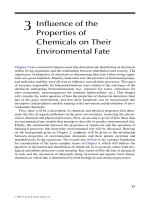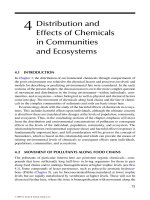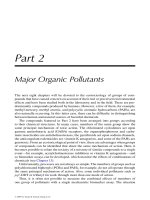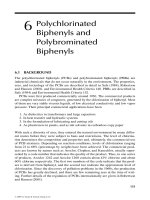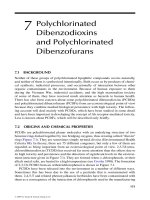ORGANIC POLLUTANTS: An Ecotoxicological Perspective - Chapter 7 pdf
Bạn đang xem bản rút gọn của tài liệu. Xem và tải ngay bản đầy đủ của tài liệu tại đây (327.38 KB, 11 trang )
151
7
Polychlorinated
Dibenzodioxins
and Polychlorinated
Dibenzofurans
7.1 BACKGROUN D
Neither of these groups of polychlorinated lipophilic compounds occurs naturally,
and neither of them is synthesized intentionally. Both occur as by-products of chemi-
cal synthesis, industrial processes, and occasionally of interaction between other
organic contaminants in the environment. Because of human exposure to them
during the Vietnam War, industrial accidents, and the high mammalian toxicity
of some of them, they have received much attention as hazards to human health.
There has also been concern about some polychlorinated dibenzodioxins (PCDDs)
and polychlorinated dibenzofurans (PCDFs) from an ecotoxicological point of view
because they combine marked biological persistence with high toxicity. The follow-
ing account will deal mainly with PCDDs, which have been studied in some detail
and have been important in developing the concept of Ah receptor-mediated toxicity.
Less is known about PCDFs, which will be described only briey.
7.2 ORIGINS AND CHEMICAL PROPERTIES
PCDDs are polychlorinated planar molecules with an underlying structure of two
benzene rings linked together by two bridging oxygens, thus creating a third “dioxin”
ring (Figure 7.1). They are sometimes simply termed dioxins (Environmental Health
Criteria 88). In theory, there are 75 different congeners, but only a few of them are
regarded as being important from an ecotoxicological point of view. 2,3,7,8-tetra-
chlorodibenzodioxin (TCDD) has received far more attention than the others due to
its high toxicity and persistence and the detection of signicant levels in the environ-
ment (structure given in Figure 7.1). They are formed when o-chlorophenols, or their
alkali metal salts, are heated to a high temperature (see Crosby 1998). The formation
of 2,3,7,8-TCDD from an orthotrichlorophenol is shown in Figure 7.1.
PCDDs have been released into the environment in a number of different ways.
Sometimes this has been due to the use of a pesticide that is contaminated with
them. 2,4,5-T and related phenoxyalkanoic herbicides have been contaminated with
them as a consequence of the interaction of chlorophenols used in the manufacturing
© 2009 by Taylor & Francis Group, LLC
152 Organic Pollutants: An Ecotoxicological Perspective, Second Edition
process. Relatively high levels of 2,3,7,8-TCDD occurred in a herbicide formula-
tion containing 2,4,5-T, which was known as “Agent Orange.” It was sprayed as a
defoliant on extensive areas of jungle during the Vietnam War. Consequently, many
humans as well as wild animals and plants were exposed to dioxin. PCDDs are also
present in pentachlorophenols, which are used as pesticides.
Industrial accidents have also led to environmental pollution by PCDDs. In 1976,
there was an explosion at a factory in Seveso, Italy, which was concerned with the
production of trichlorophenol antiseptic. A cloud containing chlorinated phenols and
dioxins was released, which caused severe pollution of neighboring areas. People
who had been exposed showed typical symptoms of early PCDD intoxication (chlo-
racne). Another source of PCDDs is the efuent from paper mills where wood pulp is
treated with chlorine (Sodergren 1991). This has been a problem in Northern Europe
(including Russia) and in North America. Evidently, chlorine interacts with phenols
derived from lignin to generate chlorophenols, which then interact to form dioxins.
Finally, PCDDs and PCDFs can be generated during the disposal of PCB residues
by combustion in specially designed furnaces. If combustion is incomplete in the
furnaces, PCDDs and PCDFs can be formed and released into the air to pollute
surrounding areas. Presumably, chlorinated phenols are rst produced, which then
interact to form PCDDs and PCDFs. Investigation of such cases of pollution has
sometimes led to the closure of the commercial operations responsible for it.
2,3,7,8-TCDD has been more widely studied than other PCDDs, and will be taken
as an example for the whole group of compounds. It is a stable solid with a melt-
ing point of 306°C. Its water solubility is very low, which has been estimated to
be 0.01–0.2 μg/L; its log K
ow
is 6.6. More highly chlorinated PCDDs are even less
soluble in water.
PCDFs are similar in many respects to PCDDs but have been less well stud-
ied, and will be mentioned only briey here. Their chemical structure is shown in
Figure 7.1. Like PCDDs, they can be formed by the interaction of chlorophenols, and
are found in commercial preparations of chlorinated phenols and in products derived
from phenols (e.g., 2,4,5-T and related phenoxyalkanoic herbicides). They are also
present in commercial polychlorinated biphenyl (PCB) mixtures, and can be formed
Cl
Cl
Cl
Cl O
Dioxin (2, 3, 7, 8-TCDD)2, 4, 5-Trichlorophenol
Dibenzofuran (2, 3, 7, 8-TCDF)
Predioxin
O
–OH
Cl
Cl
Cl
Cl
Cl
OH
+
Cl
Cl
Cl
HO Cl
Cl
–OH
Cl
Cl
Cl
Cl
O
Cl
–
O
O
FIGURE 7.1 Formation of dioxin and dibenzofuran (from Crosby 1998).
© 2009 by Taylor & Francis Group, LLC
Polychlorinated Dibenzodioxins and Polychlorinated Dibenzofurans 153
during the combustion of PCBs. They have similar physical properties to PCDDs,
and have low water solubilities and high K
ow
values. The compound 2,3,7,8-TCDF
has a log K
ow
value of 5.82. Some PCDFs bind very strongly to the Aryl hydrocarbon
(Ah) receptor.
From here on, these two related groups of pollutants will be treated together.
7.3 METABOLISM
The compound 2,3,7,8-TCDD has been much more widely studied than other PCDDs
and will be taken as representative of the group. Metabolism is slow in mammals.
Because of the high toxicity of the compound, only low doses can be given in in
vivo experiments, making the quantication of metabolites difcult. However, there
appear to be two distinct types of metabolite: (1) monohydroxylated PCDD deriva-
tives, and (2) products of the cleavage of one of the ether bonds of the dioxin ring.
Both types can be generated following epoxidation of the aromatic ring. Epoxidation
in the meta-para position yields metabolites of category 1, and epoxidation in the
ortho-para position yields metabolites of category 2 (see Environmental Health
Criteria 88, and Poiger and Buser 1983). Hydroxymetabolites excreted in rat bile are
present largely as glucuronide or sulfate conjugates.
7.4 ENVIRONMENTAL FATE
Higher chlorinated PCDDs, including 2,3,7,8-TCDD, are lipophilic and biologi-
cally stable, and are distributed in the environment in a similar fashion to higher
chlorinated PCBs, reaching relatively high levels at the top of food chains. Within
vertebrates, however, they show a greater tendency to be stored in liver, and a lesser
tendency to be stored in fat depots than most PCBs. Some biological half-lives for
2,3,7,8-TCDD are given in Table 7.1.
Because of its high toxicity, there is concern about very low levels of 2,3,7,8-TCDD
in biota. This raises analytical problems, and high resolution capillary gas chromatog-
raphy (GC) is needed to obtain reliable isomer-specic analyses at low concentrations.
In the analysis of herring gull eggs collected from the Great Lakes, Hebert et al. (1994)
TABLE 7.1
Half-Lives of 2,3,7,8-TCDD
Species Dose (route) Half-Life (days)
Rat (different strains) 1–50 μg/kg (oral) 17–31
Mouse (different strains) 0.5–10 μg/kg (ip) 10–24
Hamster 650 μg/kg (oral) 15
Guinea pig 0.56 μg/kg (ip) 94
© 2009 by Taylor & Francis Group, LLC
154 Organic Pollutants: An Ecotoxicological Perspective, Second Edition
reported the following residues of 2,3,7,8-TCDD. Further details of this study are given
in Norstrom et al. 1986.
Lake Ontario, early 1970s 2–5 μg/kg (i.e., 0.002–0.005 ppm by weight)
Lake Ontario, 1984/1985 0.08–0.1 μg/kg
Lake Michigan, 1971 0.25 μg/kg
Lake Michigan, 1972 0.07 μg/kg
Lake Michigan, 1984/1985 0.001–0.002 μg/kg
In another study conducted during 1983–85, sh from the Baltic Sea were found to
contain 0.003–0.029 μg/kg of 2,3,7,8-TCDD (Rappe et al. 1987).
Recognizing the widespread occurrence of PHAHs in the natural environment,
interest has grown in the development of simple rapid assays that can be used in a
cost-effective way to identify “hot spots,” where there are particularly high levels
of them. Indeed, a wide range of tests are now available that are suitable for such
biomonitoring (Persoone et al. 2000). In the next section, details will be given of the
CALUX assay, which is based on a line of rat hepatoma cells that are responsive to
“dioxin-like” compounds. This assay has been used for environmental monitoring. In
one study, sediments were sampled from coastal and inland sites in the Netherlands
and assayed for dioxin-like activity (Stronkhurst et al. 2002). The importance of this
approach is that it measures the operation of a toxic mechanism in environmental
samples and so brings to attention particular areas that require further investigation.
Once hot spots have been identied, chemical analysis and biomarker assays can be
used, which are expensive and time-consuming, to gain more detailed information
about the nature and scale of the problem.
7. 5 TOXICIT Y
2,3,7,8-TCDD is a compound of very high toxicity to certain mammals, and there
has been great interest in the elucidation of its mode of action. The situation is com-
plicated, at least on the surface, by the variety of symptoms associated with dioxin
toxicity. Symptoms include dermal toxicity, immunotoxicity, reproductive effects,
teratogenicity, and endocrine toxicity, which, together with induction of CYP1A,
have been associated with the very strong binding of this molecule to the Ah recep-
tor. These toxic effects have been referred to collectively as Ah-receptor-mediated
toxicity. Interestingly, a strain of mice decient in the Ah receptor do not respond
in this way to 2,3,7,8-TCDD or to related compounds that behave in a similar way
(Fernandez-Salguero et al. 1996). Although this observation supports the idea that
toxicity is being mediated through the Ah receptor, it does not prove that this is the
case. Until the mechanisms are known by which this toxicity is expressed, there will
remain questions about whether this toxicity is truly mediated through this receptor,
or whether this occurs through another receptor (or receptors) with similar binding
properties to the Ah receptor, which is similarly affected by dioxin-like compounds.
There is a further potential problem; it is well known that cytochrome P450 1A1 has
a marked capacity to activate planar compounds such as PAHs or coplanar PCBs.
To what extent, then, is Ah-receptor-mediated toxicity simply a consequence of the
© 2009 by Taylor & Francis Group, LLC
Polychlorinated Dibenzodioxins and Polychlorinated Dibenzofurans 155
enhanced activation of compounds such as these (perhaps even endogenous planar
compounds) when P450 1A1 is induced?
Apart from 2,3,7,8-TCDD, other PCDDs, PCDFs, and coplanar PCBs also inter-
act with the Ah receptor causing induction of P450 1A1 with associated toxic effects
(dioxin-like compounds). There are, however, large differences between individual
compounds of this type both in their afnity for the receptor and in their toxic
potency. Notwithstanding the theoretical uncertainties described in the preceding
text, attempts have been made to develop a practical approach for risk assessment for
these compounds more generally by estimating toxic equivalency factors (Safe 1990,
2001; Ahlborg et al. 1994).
Toxic equivalency factors (TEFs) are estimated relative to 2,3,7,8-TCDD, which is
assigned a value of 1. They are measures of the toxicity of individual compounds rel-
ative to that of 2,3,7,8-TCDD. A variety of toxic indices, measured in vivo or in vitro,
have been used to estimate TEFs, including reproductive effects (e.g., embryo toxic-
ity in birds), immunotoxicity, and effects on organ weights. The degree of induction
of P450 1A1 is another measure from which estimations of TEF values have been
made. The usual approach is to compare a dose-response curve for a test compound
with that of the reference compound, 2,3,7,8-TCDD, and thereby establish the con-
centrations (or doses) that are required to elicit a standard response. The ratio of con-
centration of 2,3,7,8-TCDD to concentration of test chemical when both compounds
produce the same degree of response is the TEF. Once determined, a TEF can be
used to convert a concentration of a dioxin-like chemical found in an environmental
sample to a toxic equivalent (TEQ).
Thus, [C] × TEF = TEQ
dioxin
, where [C] = environmental concentration of planar
polychlorinated compound. The TEQ is an estimate of the concentration of TCDD that
would produce the same effect as the given concentration of the dioxin-like chemical.
The criteria for including a compound in the aforementioned scheme and assign-
ing it a TEF value, were set out in a WHO–European Centre for Environmental
Health consultation in 1993 (Ahlborg et al. 1994). They are as follows:
1. The compound should show a structural relationship to PCDDs and
PCDFs.
2. It should bind to the Ah receptor.
3. It should elicit biochemical and toxic responses that are characteristic of
2,3,7,8,-TCDD.
4. It should be persistent and accumulate in the food chain.
Some examples of TEF values used in an environmental study on polyhalogenated
aromatic hydrocarbons (PHAHs) in sh are given in Table 7.2 (data from Giesy et
al. 1997). The rst point to notice is that values for PCDDs and PCDFs are generally
much higher than those for PCBs. Even the most potent of the PCBs, 3,3b,4,4b,5-PCB,
only has a TEF value of 2.2 × 10
−2
, which is lower than nearly all the values for
PCDDs and PCDFs. That said, PCBs tend to be at much higher concentrations in
environmental samples than the other two groups, with the consequence that they
have been found to contribute higher overall TEQ values than PCDDs or PCDFs in
many environmental samples despite their low TEF values.
© 2009 by Taylor & Francis Group, LLC
156 Organic Pollutants: An Ecotoxicological Perspective, Second Edition
Up to this point, discussion of TEQs has been restricted to their estimation from
concentrations of individual compounds determined chemically, employing TEFs as
conversion factors. It is also possible to measure the total TEQ value directly by means
of a bioassay. Rat and mouse hepatoma lines, which contain the Ah receptor, show
P450 1A1 induction when exposed to planar PHAHs. The degree of induction can be
measured in terms of the increase in ethoxyresorun-O-deethylase (EROD) activity
(see Chapter 2). One example of a cellular line of this type is the rat H4 IIE line, which
has come to be widely used for environmental bioassays (see, for example, Giesy et
al. 1997, Koistinen 1997, and Whyte et al. 1998). A development of this approach
is the “chemically activated luciferase gene expression,” or CALUX, assay (Aarts
et al. 1993, Garrison et al. 1996). Here, a reporter gene for the enzyme luciferase is
linked to the operation of the Ah receptor, so the degree of induction is indicated by
the quantity of light that is emitted by the cells. This system has the advantage of not
requiring an EROD assay to determine TEQ values. Values obtained by the direct
measurement of TEQ (i.e., TCDD equivalents) using cellular systems can be directly
compared to values estimated from chemical data using TEFs.
When using TEFs to estimate TEQs, it is assumed that all of the compounds
are acting by a common mechanism through a common receptor, and that effects
of individual components in a mixture are simply additive, without potentiation or
antagonism. There are, however, reservations about adopting such a simple approach
too generally. For one, the mechanism of toxicity has not been elucidated, and there
may be toxic mechanisms operating, thus far unidentied, which do not involve the
Ah receptor. It is true that early application of the approach in human toxicology
produced relatively consistent results that tended to encourage this simple approach.
In studies with experimental animals (mainly rodents), the summation of TEQ val-
ues for mixtures of compounds have often been found to relate reasonably well to
TABLE 7.2
TEF Values for Polyhalogenated Aromatic Hydrocarbons Used
in a Study of Residues in Fish
Compound TEF Compound TEF
PCDDs Nonortho PCBs
1,2,3,7,8-PCDD 4.2 × 10
−1
3,4,4b,5-TCB
1.9 × 10
−3
1,2,3,4,7,8-HCDD 8.3 × 10
−2
3,3b,4,4b-TCB
1.8 × 10
−5
1,2,3,4,6,7-HpCDD 2.3 × 10
−2
3,3b,4,,4b,5-PCB
2.2 × 10
−2
PCDFs Mono-ortho PCBs
2,3,7,8-TCDF 2.0 × 10
−1
2,3b,4,3b,4b,5-PCB
3.5 × 10
−7
2,3,4,7,8-PCDF 2.8 × 10
−1
2,3,3b,4,4b-PCB
8.0 × 10
−6
1,2,3,6,7,8-HCDF 6.0 × 10
−1
2,3,3b,4,4b,5-HCB
5.5 × 10
−5
1,2,3,4,7,8,9-HpCDF 2.0 × 10
−2
2,2b,3,4,4b,5b-HCB
1.5 × 10
−5
Source: Data from Giesy et al. (1997).
© 2009 by Taylor & Francis Group, LLC
Polychlorinated Dibenzodioxins and Polychlorinated Dibenzofurans 157
toxic effects (see the following text). However, there is now evidence suggesting that
PHAHs can express toxicity by other mechanisms, for example, in certain cases of
developmental neurotoxicity and carcinogenicity (Brouwer 1996, Verhallen et al.
1997). Also, PCBs in mixtures have sometimes shown antagonistic effects, so addi-
tivity cannot be automatically assumed (Davis and Safe 1990, Giesy et al. 1997).
The use of TEQs in environmental risk assessment has great attractions. It offers
a way of tackling the problem of determining the biological signicance of levels
of diverse PHAHs found in mixtures. There are, however, practical and theoretical
problems that need to be resolved before it can be widely used with condence. First,
the issue—to what extent can the variety of toxic effects caused by PHAHs in verte-
brates generally be explained in terms of Ah-receptor-mediated toxicity? Only lim-
ited work has been done on birds or sh, and practically nothing on amphibians or
reptiles. So, this question extends far beyond the limited number of species of experi-
mental animals so far studied. Second, even if it were possible to restrict the argu-
ment to effects that are directly associated with binding of PHAH to the Ah receptor,
how comparable are the Ah receptors of unrelated species? It has been suggested that
the Ah receptor is highly conserved and may not differ very much between groups
of vertebrates. However, in eld studies, there have sometimes been large differ-
ences between species in the relationship between TEQ values and toxic effects (see
Ludwig et al. 1996, McCarty and Secord 1999, and further discussion in Chapter 6,
Section 6.2.4 and Chapter 7, 7.2.5). Also, work on the estuarine sh, Fundulus het-
eroclitus, has revealed the existence of a strain inhabiting a polluted area that is resis-
tant to dioxin-like compounds (see Chapter 6, Section 6.2.5). This species evidently
possesses two forms of the Ah receptor, AHR1 and AHR2, which have differential
tissue expression in susceptible strains as compared with the resistant strain (Powell
et al. 2000). The upshot is that the resistant strain has a greater predominance of the
form of the Ah receptor, which is insensitive to dioxin-like compounds, and this pro-
vides the basis of the resistance. Indeed, this type of resistance mechanism is appar-
ently similar to that found in many strains of insects that have acquired resistance to
insecticides, namely, target insensitivity. Examples include insensitive forms of the
sodium channel, which confer resistance to DDT and pyrethroids (Chapter 5, Section
5.2.5.1, and Chapter 12, Section 12.6), insensitive forms of GABA receptors, which
confer resistance to cyclodienes (Chapter 5, Section 5.3.5.2), and aberrant forms of
acetylcholinesterase, which confer OP resistance. Thus, it seems that the application
of the TEQ concept in ecotoxicology is complicated by the fact that there are differ-
ent forms of the Ah receptor with differential sensitivities to dioxin-like compounds.
Such differences may be expected to cause different responses to these compounds
not only between strains but also between species, sexes, and age groups. A further
likely consequence is that there will be differences in the comparative potency of
individual dioxin-like compounds when interacting with contrasting forms of the
Ah receptor. Thus, TEF values are likely to show species and strain variation, which
may go some way to explaining some of the anomalies in eld data, to be discussed
in Section 7.6.
More work needs to be done to clarify this. At the moment, the TEF values in use
have been obtained for a very limited number of species. There needs to be caution
in using them for calculating TEQs in untested species.
© 2009 by Taylor & Francis Group, LLC
158 Organic Pollutants: An Ecotoxicological Perspective, Second Edition
Because of the concern over human health hazards associated with PCDDs,
many toxicity tests have been performed on rodents. Some toxicity data are given for
2,3,7,8-TCDD as follows:
Acute oral LD
50
/rat: 22–297 μg/kg (Different strains were tested)
Acute oral LD
50
/mice: 114–2570 μg/kg (Different strains were tested)
Acute oral LD
50
/guinea pig: 0.6–19 μg/kg
A variety of toxic symptoms were shown, the pattern differing between species.
There were often long periods between commencement of dosing and death. There
were also large species differences in toxicity, the guinea pig being extremely sus-
ceptible, the mouse far less so. However, the critical point is that 2,3,7,8-TCDD is
an exceedingly toxic compound even to the mouse. With such differences in toxicity
between closely related species, it seems probable that there will be even larger dif-
ferences across the wide range of vertebrate species found in nature.
2,3,7,8-TCDF is not very toxic to the mouse (acute oral LD
50
< 6000 μg/kg) but is
highly toxic to the guinea pig (acute oral LD
50
5–10 μg/kg). Symptoms of toxicity in
the guinea pig were similar to those found with 2,3,7,8-TCDD. Thus, the selectivity
pattern was similar to that for 2,3,7,8-TCDD, but toxicity was considerably less (see
Environmental Health Criteria 88).
7.6 ECOLOGICAL EFFECTS RELATED TO TEQS FOR 2,3,7,8-TCDD
Estimates of TCDD toxicity in eld studies have depended on the estimates of TEQ
values in an attempt to relate Ah-receptor-mediated toxicity caused by total PHAHs
to effects on individuals and populations. Although some encouraging progress
has been made, there have also been a number of problems. Not infrequently, TEQ
values determined by bioassay have considerably exceeded values calculated from
chemical data using TEFs. These discrepancies have not been explicable in terms of
antagonistic effects, and the balance of evidence suggests that environmental com-
pounds other than the PHAHs determined by analysis have contributed to the mea-
sured TEQ values. This has been observed in studies on sh (Giesy et al. 1997) and
white-tailed sea eagles (Haliaetus albicilla) (Koistinen et al. 1997). In the study on
sh, as much as 75% of the measured TEQ could not be accounted for using chemi-
cal data. The results of a number of studies are summarized in Table 7.3.
The results for the double-crested cormorant and the Caspian tern in the Great
Lakes both show a relationship between TEQs and reproductive success. They
were obtained during the late 1980s, at a time when DDE-related thinning of egg-
shells had fallen and TEQ values were based on PCBs alone. However, in certain
areas PHAH levels remained high, and populations of these two species were still
depressed. These investigations suggested that populations were still being adversely
affected by PHAHs as a consequence of Ah-receptor-mediated toxicity. The data
for white-tailed sea eagles from the Baltic coast also relate to an area where, at the
time of the investigation, there was evidence of reduced breeding success in the local
population—at a time when the species was increasing elsewhere in Scandinavia.
The TEQs in the most highly contaminated individuals were high enough to support
the suggestion that PHAHs were contributing to lack of breeding success.
© 2009 by Taylor & Francis Group, LLC
Polychlorinated Dibenzodioxins and Polychlorinated Dibenzofurans 159
TABLE 7.3
TEQ Values Found in Field Studies, and Ecological Effects Associated with Them
Area Species
TEQ pg/g
(method of
determination) Observation Reference
Great Lakes Double-crested
cormorant
(eggs)
100–300
(bioassay); only
PCBs assayed
Egg mortalities of
8–39% correlated
well with TEQ values
Relationship to
continued poor
breeding success
Tillett et al.
(1992)
Caspian tern
(eggs)
170–400
(chemical
analysis); only
PCBs assayed
Related to embryonic
mortality
Ludwig et al.
(1996)
2700 Total reproductive
failure
Ludwig et al.
(1993)
Baltic Sea White-tailed
sea eagle
(egg, muscle)
<1220 (bioassay)
<1040 (chemical
determination)
PCB fraction
accounted for 75%+
of TEQ by either
assay; reduced
productivity of birds
in this area
Koistinen et al.
(1997)
Upper Hudson
River
Tree swallows
(Tachycineta
bicolor)
410–25,400
(chemical
determination)
TEQs mainly due to
PCBs, especially
3,3b,4,4b-TCB
Secord et al.
(1999)
(nestlings) Reduced reproductive
success, but less
effect than expected
from high TEQs
McCarty and
Secord (1999)
Saginaw Bay,
Great Lakes
Fish (whole
body);
sampled 1990
11–348
(bioassay);
14–70 (chemical
determination)
PCDDs, PCDFs, and
PCBs made variable,
but on the whole
similar contributions
to TEQ values;
probably not high
enough to adversely
affect sh
populations
Giesy et al.
(1997)
Woonasquatucket
River
Tree swallows
eggs
343–1281
(chemical
determination)
TCDD mainly
2,3,7,8-TCDD
Reduced hatching
success
Custer et al.
(2005)
The results for tree swallows (Tachycineta bicolor) in the area of the Upper
Hudson River are surprising because the birds were still able to breed with TEQs far
above the levels that had severe/fatal effects on other species of birds. However, there
© 2009 by Taylor & Francis Group, LLC
160 Organic Pollutants: An Ecotoxicological Perspective, Second Edition
was evidence of reduced reproductive success in 1994, and of high rates of aban-
donment of nests and supernormal clutches in 1995 (McCarty and Secord 1999).
It would appear that tree swallows are particularly insensitive to this type of toxic
action. This nding raises questions about the validity and wider applicability of the
use of TEQ values and brings to mind the large interspecic differences in TCDD
toxicity found in some toxicity tests.
In another study of tree swallows at a Superfund site along Woonasquatucket
River, Rhode Island, during 2000–2001, exceptionally high levels of 2,3,7,8-TCDD
were found in eggs from the most polluted areas (300 to >1000 pg/g wet weight).
Eggs sampled from a reference site contained only 12–29 pg/g. Concentrations in
the food of the birds were more than 6–18 times higher than that regarded as safe
for birds (10–12 pg/g). Hatching success was negatively correlated with TCDD con-
centrations in eggs, and only about 50% of eggs hatched in the most polluted area,
compared to >77% in the reference area. In contrast to the study described in the
area of the Hudson River, 2,3,7,8-TCDD was the dominant residue so far as TEQ
estimations were concerned. PCB levels were below those known to affect avian
reproduction (Custer et al. 2005).
A noteworthy nding of the investigations thus far is the considerable variation
in the relative contributions of PCBs, PCDDs, and PCDFs to TEQ values deter-
mined for wild vertebrates. Thus, the TEQ values for white-tailed sea eagles and
tree swallows on the Hudson River were accounted for very largely by coplanar
PCBs, whereas 2,3,7,8-TCDD was dominant in tree swallows in the Rhode Island
study area. Fish from Saginaw Bay showed relatively low TEQs. PCDDs, PCDFs,
and PCBs all made similar contributions to TEQ. There was considerable variation
between species and age groups of sh, with contributions to total TEQs in the fol-
lowing ranges:
PCDD: 5–38%
PCDF: 13–69%
PCB: 10–50%
7.7 SUMM ARY
Both PCDDs and PCDFs are refractory lipophilic pollutants formed by the interac-
tion of chlorophenols. They enter the environment as a consequence of their pres-
ence as impurities in pesticides, following certain industrial accidents, in efuents
from pulp mills, and because of the incomplete combustion of PCB residues in fur-
naces. Although present at very low levels in the environment, some of them (e.g.,
2,3,7,8-TCDD) are highly toxic and undergo biomagnication in food chains.
PCDDs and PCDFs, together with coplanar PCBs, can express Ah-receptor-
mediated toxicity. TCDD (dioxin) is used as a reference compound in the determina-
tion of TEFs, which can be used to estimate TEQs (toxic equivalents) for residues
of PHAHs found in wildlife samples. Biomarker assays for Ah-receptor-mediated
toxicity have been based on the induction of P450 1A1. TEQs measured in eld
samples have sometimes been related to toxic effects upon individuals and associ-
ated ecological effects (e.g., reproductive success).
© 2009 by Taylor & Francis Group, LLC
Polychlorinated Dibenzodioxins and Polychlorinated Dibenzofurans 161
FURTHER READING
Ahlborg et al. (1996). Discusses the wider use of TEFs.
Environmental Health Criteria 88 (1989). Gives information on the environmental toxicology
of PCDDs and PCDFs.
Safe, S. (1990). An authoritative account of the development of TEFs.
© 2009 by Taylor & Francis Group, LLC

